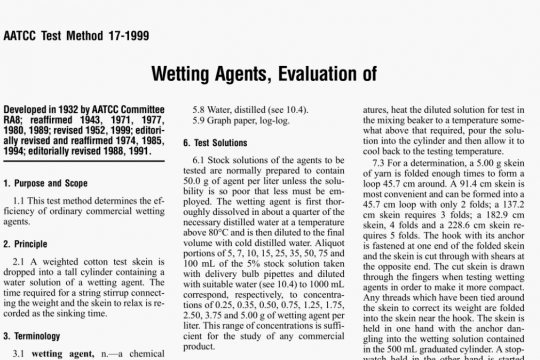AATCC 162 pdf free download
AATCC 162 pdf free download.Colorfastness to Water: Chlorinated Pool.
4.4 An cycwashlsafcty shower should be located nearby and a high efficiency particulate respirator with a full face- piece should be readily available for emergency use.
4.5 Manufacturer’s safety recommendations should be followed when operating 1 aboratory testing equipment.
4.6 Observe padder safety. Ensure adequate guard at the nip point. Normal safeguards on pad should not be removed. A foot-operated kickoff is recommended.
4.7 Exposure to chemicals used in this procedure must be controlled at or below levels set by governmental authorities (e.g., Occupational Safety and Health Administration’s [OSFIA] permissible exposure limits [PEL] as found in 29 CFR 1910.1000 of January 1, 1989). In addition, the American Conference of Governmental Industrial Hygienists (ACGIH) Threshold Limit Values (TLVs) comprised of time weighted averages (TLV-TWA). short term exposure limits (TLV-STEL) and ceiling limits (TLV-C) are recommended as a general guide for air contaminant exposure which should be met (see 11.1).
5. Apparatus and Materials
5.1 SGS U.S. Testing Co. Inc. dry- cleaning and washing machine #6523 (see 11.2).
5.2 Wringer (see 11.3).
5.3 Gray Scale for Color Change (see
11.7).
5.4 Household sodium hypochlorite solution (NaOCI), approximately 5% available chlorine (see 11.4).
5.5 Calcium chloride. anhydrous (CaC1.,) (see 11.5).
5.6 Magnesium chloride. hexahydrate (MgCI2 6H10) (see 11.6).
5.7 Test Control Fabric 162 (see 11.7).
5.8 Sulfuric acid (H2SOj, 6N.
5.9 Potassium iodide, KI, 12%.
5.10 Starch solution. 1%.
5.11 Sodium thiosulfate (Na2S,03),
0.lN, (see 11.8).
5.12 Distilled or deionized water.
5.13 Sodium carbonate (NaCO).
5.14 Acetic acid (CHCOOH).
7. Test Specimens
7.1 Colored specimens, approximately
6 x 6 cm. Total weight of test specimens should be 5.0 ± 0.25 g. If specimens to be tested do not weigh 5.0 g, add multiple specimens to make 5.0 g. Include the Test Control Fabric in the 5.0 g weight. Different colored specimens can be mixed when making up the 5.0 g load.
8. Procedure
8.1 Purge the drycicaning cylinder. Add approximately 5000 mL deionized water and 0.5 mL Clorox or equivalent (see 11.4). Close cylinder and run for 10 mm (purging is necessary only if cylinder has been used for testing other than chlorinated pool water, or has not been used tbr a period of two weeks). Discard this solution.
8.2 Prepare hardness concentrate.
8.2.1 Weigh out 8.24 g calcium chloride. anhydrous.
8.2.2 Weigh out 5.07 g magnesium chloride hexahydrate, MgCl 6 H,O.
8.2.3 Add 800 mL deionized or distilled water to a I L volumetric flask; add calcium chloride and magnesium chloride while stirring to dissolve. Bring volume up to I L with water. This is a “hardness concentrate” which can be retained and used for 30 days.
8.3 Dilute 51 mL hardness concentrate to 5100 mL with deionized or distilled water. Add 0.5 ml. Clorox or equivalent which is no more than 60 days old. Determine actual ppm Cl by titration and adjust to 5 ppm (sec 11.8).
8.3.1 0.0 IN Sodium thiosulfate can be purchased in this form or can be diluted 10 to 1 volumetrically from 0. IN solution.
8.4 Adjust solution to pH 7.0 with sodium carbonate or acetic acid as necessary.
8.5 Place the 5000 ml. solution (from
8.3) in the cylinder of the testing machine. Adjust temperature to 21°C (70°F).
8.6 Place colored test specimens including test control fabric in cylinder. close and tumble tbr 60 mm.
8.7 Remove the test specimens and pass through wringer to remove excess solution. Rinse thoroughly with deionized or distilled water. Wring again and allow to dry on absorbent, bleached paper toweling at room temperature.AATCC 162 pdf download.




